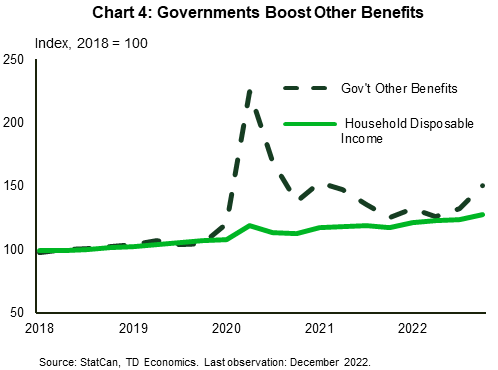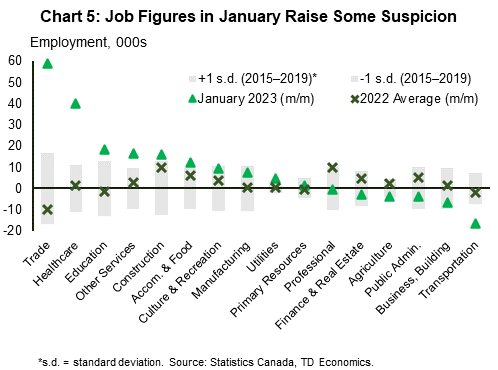
The Bank of Canada:
Stuck in the Middle with You
Beata Caranci, SVP & Chief Economist | 416-982-8067
Date Published: March 7, 2023
- Category:
- Canada
- Financial Markets
The Thread
- In January, I wrote about the lessons learned from the Bank of Canada having left the overnight rate too low for too long once the pandemic crisis period had passed. An important conclusion was that the decision framework should have considered the impact of unprecedented and far-reaching government spending initiatives.
During any crisis period, it's important to have both fiscal and monetary institutions row in the same direction with their policy tools. But combining super-sized government spending with ultra-low interest rates was like strapping a V12 outboard motor to a canoe! The economy was not just propelled forward but became far more difficult to maneuver and control.
Here we are in 2023, observing a defiant consumer in the face of spiking interest rates and high inflation. Real consumer spending ended last year growing a robust 2%, and our TD Spend data predicts another decent clip to start this year (Chart 1). Long gone is the spring and summer cautiousness of last year that set in under the shock of high gasoline prices and peak inflation. - Unrelenting strength in the Canadian job market is propelling consumer spending and confidence. In just two months, Canadian firms hired an entire year's worth of workers. This happened in an economy that surpassed its pre-pandemic job level 13 months ago. In other words, it's already a mature job market.
Now the question is: how long can this resilience persist? We characterized jobs into two categories: those that tend to be cyclical versus those that are not (Chart 2). Non-cyclical sectors include government, health, education, utilities and agriculture. While cyclical jobs represent the bulk of the overall market, the latest hiring push has come more from the smaller non-cyclical sector. This means that an economic downturn may not materially erode these jobs. Those employers are more likely to slow new hiring than lay off workers. And, as we are already getting a glimpse within government budget announcements, jobs within the health care and education sectors are priorities for the coming years, offering a counterweight to any layoffs that might emerge within the cyclical side of the economy.
But even within the cyclical industries, the job market may unfold differently in a downturn. Big and unprecedented government initiatives on climate change and infrastructure could provide a floor under jobs typically characterized as cyclical, like construction and manufacturing. - However, there's more to the consumer resilience story for the Bank of Canada to consider…much more. Another factor that may be contributing to the lagged response of households to the inflation and interest rate environment is captured in Chart 3, where we compare the average Canadian household's increase in debt service costs this year to the new money they will receive from the combination of daycare subsidies and several one-off provincial inflation relief programs. This does not include new announcements with the 2023 government budget season underway.
Since the data is just a simple per household average, it is not necessarily representative of who holds the debt versus who is receiving the subsidies. But it makes a simple point. Financial tightening by the Bank of Canada is being mitigated by government programs.
Focusing only on the portion of households that use daycare facilities reveals a much higher level of savings of almost $6,000. If that same household has a variable interest rate mortgage or one coming up for renewal, the payment shock would be more easily absorbed. - Another striking statistic is captured within nominal after-tax income. It was up 8.5% in the final quarter of 2022 relative to the prior year, although that's flattered by a weak base-year. Nonetheless, this exceeds inflation and reflects a combination of strong employment income and an ongoing surge in government transfers. The latter is of note given it's working at odds with the Bank of Canada's objective to calm the impulse to inflation from buoyant domestic demand.
Digging deeper, nominal after-tax income rose by $45 billion (saar) in the fourth quarter relative to the prior one, but more than half was driven by government transfers. It was a similar story in the third quarter with government transfers accounting for the thrust of the gains in disposable income. This was not the result of amped-up social security or employment insurance benefits, but came through a subcomponent called "other benefits" which has yet to normalize to pre-pandemic trends (Chart 4). This category is a catch-all for anything that doesn't conform to the usual classifications. For instance, in the fourth quarter, Quebec's Anti-inflation Shield policies would be deposited. These transfers benefited households at all income levels with the distribution of one-time cheques. Saskatchewan also delivered a one-time payment to households that filed a tax return in 2021, regardless of income level. Many provinces delivered more targeted one-time measures to seniors, renters and low-income households in the second half of the year, while the Federal government doubled the tax credit on the GST for six months, alongside a permanent 10% increase on OAS for those 75 years and older. Many initiatives are well intentioned, particularly those targeted at the most vulnerable population. But, they are also occurring during a period of historically high labour demand and rapid wage growth that could frustrate the BoC's attempt to cool demand pressures. - This Friday, employment data for the month of February will be released and they need to show some waning of past strength, otherwise the BoC's conditional pause will certainly come into question. On this front, we think there's reason to take January's outsized 150 thousand job gain with a grain of salt.
Chart 5 shows the typical monthly range in hiring by industry within one standard deviation. On average, hiring behaviour last year fell within that range. This was not the case in January for two industries: healthcare and trade. The latter includes both the retail and wholesale sectors, which sat at an eye-popping positive three standard deviations. This was all the more peculiar because retail jobs had been declining for seven straight months prior. So, why would employers suddenly reverse course? They probably didn't, or at least not to this magnitude.
Every January brings a seasonal release of retail workers after the holiday period. But this time it was the smallest in history. The January data is likely reflecting some amount of distortion related to the seasonal adjustment that went askew during the pandemic when the retail industry bore a disproportionate burden of government restraints over the winter months.
In addition, although the industry faced no such restraints this time around, behavioural shifts may have impacted businesses in not wanting to staff-up too much during the holiday season, with recession calls reaching a feverish pitch amidst a historic rise in interest rates. It's highly doubtful that January's job demand strength will carry forward in the coming months and, in fact, we could be in for a big reversal as the seasonal factors recalibrate in the other direction.
The outsized gain in the health sector is also a historic departure in magnitude, although that gain completely offsets a loss in the prior month. Strength in this sector is more intuitive based on where shortages are reported and government spending is ramping up, but the degree of month-to-month volatility certainly falls on the suspicious side.
You might have also noticed that six of the 15 industries posted flat-to-negative hiring in January, which were washed out by the heavy hitters. So, we are confident that there are data anomalies, which means exercising caution on being too literal with the month-to-month gyrations in the data. Still, even if those job figures are subsequently cut in half, with revisions or partial reversals in the coming months, it would still reflect a strong job market that would be inconsistent with sustained 2% inflation. The Canadian job market has to get to a stall-speed over at least a couple of quarters to inject that confidence, particularly given the income-boosters noted earlier that are still feeding through the pipeline. - Within the context of several cross winds that are lifting savings and income, it seems reasonable that households across the spectrum have become somewhat desensitized to the interest rate cycle in the near-term. This doesn't mean that businesses will endlessly hire if they're at full capacity, or consumers will endlessly spend in a higher rate environment. But it could lead to longer lags in traditional economic relationships, and perhaps even more muted relationships for a given change in interest rates.
The Bank of Canada has stated it's in observation-mode with a conditional pause on interest rates at 4.50%. Monitoring government spending initiatives during this budget season should be part of that conditionality, particularly if paralleled with ongoing job market resilience that creates persistence with inflation. Many governments are benefiting from better revenue growth and transfers than originally projected, creating an impulse to ramp up spending in areas that are future-focused, while simultaneously loosening the fiscal-restraint on shorter term temptations. Internalizing government initiatives within the central bank's policy decision framework is just as important now, as it was during the pandemic.





Disclaimer
This report is provided by TD Economics. It is for informational and educational purposes only as of the date of writing, and may not be appropriate for other purposes. The views and opinions expressed may change at any time based on market or other conditions and may not come to pass. This material is not intended to be relied upon as investment advice or recommendations, does not constitute a solicitation to buy or sell securities and should not be considered specific legal, investment or tax advice. The report does not provide material information about the business and affairs of TD Bank Group and the members of TD Economics are not spokespersons for TD Bank Group with respect to its business and affairs. The information contained in this report has been drawn from sources believed to be reliable, but is not guaranteed to be accurate or complete. This report contains economic analysis and views, including about future economic and financial markets performance. These are based on certain assumptions and other factors, and are subject to inherent risks and uncertainties. The actual outcome may be materially different. The Toronto-Dominion Bank and its affiliates and related entities that comprise the TD Bank Group are not liable for any errors or omissions in the information, analysis or views contained in this report, or for any loss or damage suffered.
Download
Download
Share this: